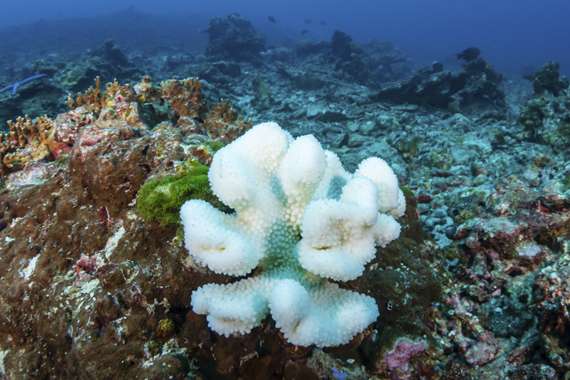Preserving Reef Reputation as Coral Bleach Coverage Hits
Description
The health of the Great Barrier Reef has huge economic importance and value to the reef tourism dependent Queensland communities of Cairns, Port Douglas and the Whitsundays. Over 18 months, CQUniversity's Cairns Airport Survey heard from nearly 2000 visitors to the region about how global coverage of coral bleaching impacted both expectations and experience, even as coral bleaching events were occurring.
Partners
Reef and Rainforest Research Centre (RRRC), Cairns International Airport and the Cairns community
Impact
CQUniversity's Cairns Airport Survey results show the significance of media reporting in destination image building. The report paves the way for local tourism bodies to develop a more comprehensive media strategy designed to promote the Great Barrier Reef and local projects dedicated to preserving it, and for enhancing overall resilience of tourism and communities in the region.
Professor Bruce Prideaux, Dr Julie Carmody and Dr Anja Pabel
Coral bleaching on the Great Barrier Reef (GBR) has made headlines around the world – but what do visitors to Far North Queensland think about the news? The answer could have big implications for the future of eco-tourism in the region, and in 2015, CQUniversity researchers from the Centre for Tourism and Regional Opportunities (CTRO) embarked on a journey to find out.
Based in Cairns, CTRO director and Tourism and Marketing Discipline Lead Professor Bruce Prideaux said the forecast bleaching in 2016 and a further event in 2017 provided a unique opportunity for researchers to understand the changing landscape. "We designed a survey that captured visitors' views on the bleaching and enabled comparisons to be made of the pre-, during and post-event reactions," explains Prof Prideaux.
Conducted twice monthly throughout 2016 and through to June 2017 in the domestic lounge of Cairns International Airport, the survey formed part of CQUni's long-running tourism monitoring program. The 10-minute survey gathered 1817 responses across those 18 months, with 45 per cent domestic visitors and 55 per cent international travellers.
"Across both groups, we saw respondents were generally aware that coral bleaching was occurring – and there was a high and increasing level of concern amongst visitors about bleaching events," says Prof Prideaux. "Obviously, these were visitors who had made the trip despite these concerns – but the results suggest further bleaching events could prompt decisions to avoid the region if potential visitors perceive patterns of degradation in the future."
Interestingly, domestic visitors were much less motivated by the reef than international visitors and may have been more impacted by bleaching reports – over the 18 months of the survey, the average ranking of the GBR as a key travel motive for Australians fell from third to the ninth position, after lifestyle attributes such as fun, rest and relaxation, tropical lifestyle and climate.
The global brand of the GBR remained strong across this time, though consistently ranked as the number one reason for international visitors to come to the region. And the more good news in the results – across the survey timeline, events of coral bleaching didn't appear to impact the GBR experiences of those surveyed during and after the events.
"Even at the height of the coral bleaching in 2016, less than five per cent of respondents rated their GBR experience as poor or awful – and positive responses remained consistent across the survey period. Sadly that message – that tourists are still wowed by our region's big natural drawcard – wasn't picked up in the media or used effectively by tourism operators to combat a lot of negative media coverage about bleaching.
"And yet we know that the only time respondents' consistently "good" rating of their experience dipped was in Quarter 2, 2016 – about the same time that reports of coral bleaching first appeared in the media.
"The 'good' rating recovered by the next quarter and stayed consistent throughout bleaching in 2017 – suggesting the impact of the media message may have played a bigger part than the condition of the coral itself.
"Going forward, understanding how visitors and potential visitors are being impacted by reporting of bleaching, but also how they're experiencing it, is vital for the industry to be proactive with its messages about the condition of the reef."
The report Impacts of the 2016 and 2017 mass coral bleaching events on the Great Barrier Reef tourism industry and tourism-dependent coastal communities of Queensland was funded by the Reef and Rainforest Research Centre. Since its establishment in 2015, the CTRO has focused on a range of tourism development initiatives, with research projects including the Cairns Region Visitor Survey, industry research needs analysis, history and tourism development, and supply analysis for the region's Indigenous tourism industry.
CTRO is jointly run by CQUni's School of Business and Law and the Indigenous Engagement Division and administered from CQUniversity's Cairns campus. Research is organised into four thematic areas: tourism development, Indigenous development and cultural capital, regional communities and growth and natural assets and environment.
Connect with CQUniversity
At CQUniversity we know the value of our connections locally and around the world. Our partnerships help us create opportunities, deliver solutions and change lives. From time to time, we share our Connections Count update, where we share our highlights, including research impact stories like the ones below. Sign up to become one of our valued connections.

